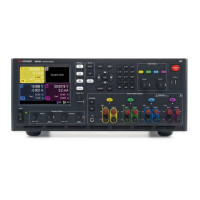It will be necessary to initiate the measurement trigger system each time a triggered
measurement is desired.
Trigger the Measurement
The trigger system is waiting for a trigger signal in the initiated state. You can immediately trigger the
measurement as follows:
TRIG:ACQ (@1)
Alternatively, if the trigger source is BUS, you can also program a *TRG or an IEEE-488 <get>
command.
As previously discussed, a trigger can also be generated by another output channel or an input pin on
the digital port connector. If any of these systems are configured as the trigger source, the instrument
will wait indefinitely for the trigger signal. If the trigger does not occur, you must abort the
measurement.
To abort the measurement and return the trigger system to the Idle state:
ABOR:ACQ (@1)
Retrieve the Measurement Data
After a trigger is received and the measurement completes, the trigger system will return to the idle
state. When this occurs, you can use FETCh queries to return specific voltage or current data from a
previously triggered measurement. FETCh queries do not alter the data in the measurement buffer.
To return average voltage & current:
FETC:VOLT?(@1)
FETC:CURR?(@1)
To return RMS voltage & current:
FETC:VOLT:ACDC?(@1)
FETC:CURR:ACDC?(@1)
To return the high level of a pulse:
FETC:VOLT:HIGH?(@1)
FETC:CURR:HIGH?(@1)
To return the low level of a pulse:
FETC:VOLT:LOW?(@1)
FETC:CURR:LOW?(@1)
To return the maximum value:
FETC:VOLT:MAX?(@1)
FETC:CURR:MAX?(@1)
To return the minimum value:
FETC:VOLT:MIN?(@1)
FETC:CURR:MIN?(@1)
Keysight N6705C Operating and Service Guide 205
6 Advanced Source, Measurement, and Control

